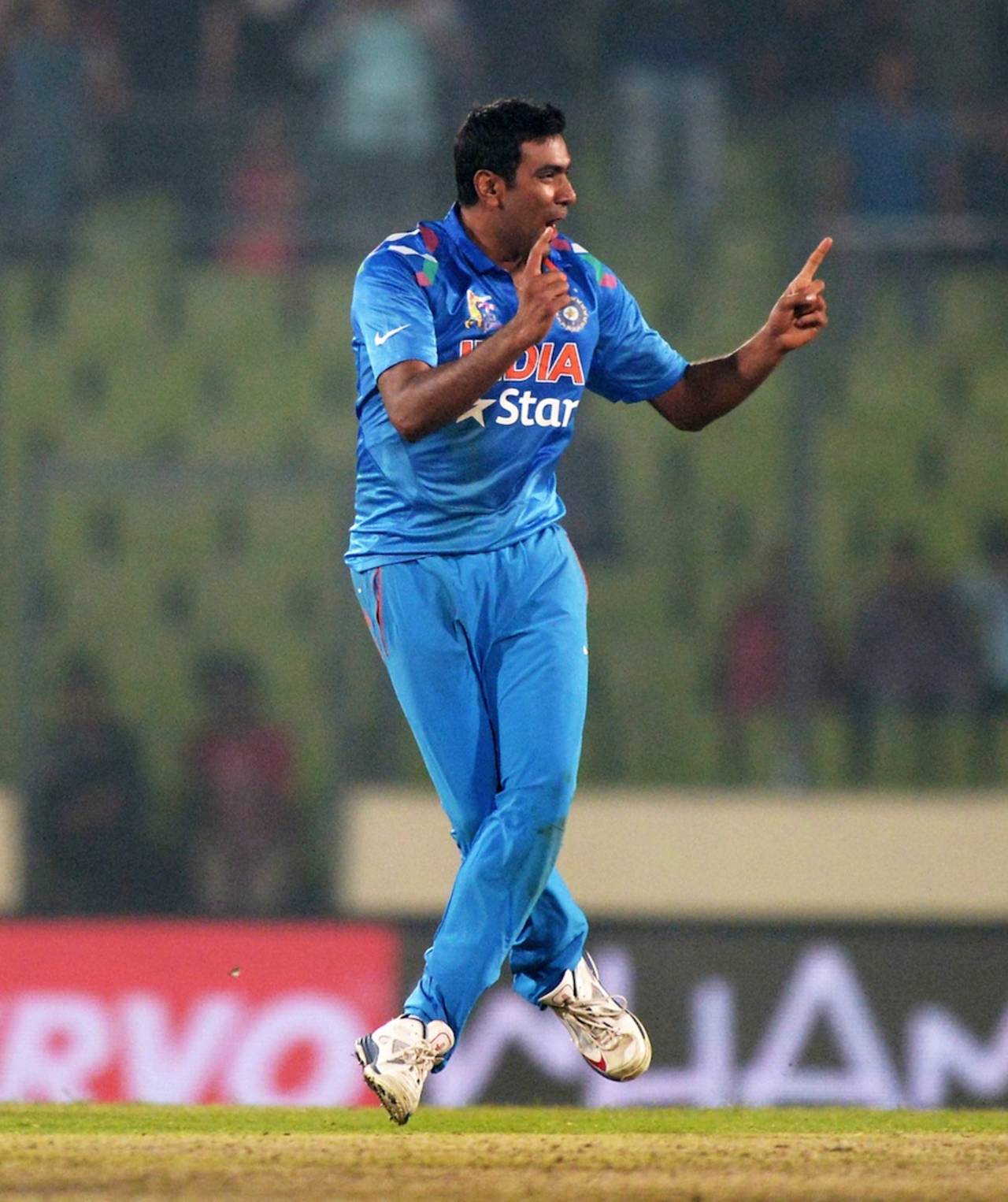Ashwin back in business after going on the attack
R Ashwin has always looked a better bowler when he has tried to take wickets, as was showcased in the Asia Cup
Karthik Krishnaswamy in Mirpur
05-Mar-2014

R Ashwin's bowling more carrom balls is an indicator that he is looking to take wickets • AFP
All through his career, advice has followed R Ashwin wherever he has gone. Most of it has gone like this: don't try too many things; focus on your stock ball; stop bowling that carrom ball so much.
After nightmare tours of South Africa and New Zealand, in which he lost the lead spinner's place in the Test eleven and took just two wickets in eight ODIs at an average approaching 200, Ashwin seems to have taken all that advice and thrown it in the bin.
On Wednesday, he took three wickets against Afghanistan, two of them - the lbws of Mohammad Shahzad and Shapoor Zadran - with the carrom ball. He ended the Asia Cup with nine wickets; he took five of them with the carrom ball.
It's hard to remember Ashwin using the carrom ball this often in recent times. During the ODIs in New Zealand, he slipped it in every now and then, but apart from one spell to Ross Taylor in Hamilton, he didn't really use it in a sustained manner. And that, contrary to popular opinion, is exactly how he has used it for most of his career.
A look through his list of wickets reveals it is likely that only 19 out of Ashwin's 106 ODI wickets have come via the means of the carrom ball. He used it quite a lot in his early matches, but as batsmen around the world grew more comfortable with it, he began deploying it far less frequently. This was a completely natural cycle of evolution.
Along with this, however, he frequently bowled with less than optimal control. Against England at home, he provided a steady diet of leg-side singles to the right-hand batsmen and fed Alastair Cook's cut with a regular supply of short balls.
He seemed to work this out when Australia came visiting, with his then coach Sunil Subramaniam helping him correct his set-up at the bowling crease, aligning the heel of his landing front-foot with the toe of his back-foot. This change allowed Ashwin to bowl with more of a pivot, put more of his body into his action, and extract more help, as a consequence, out of the pitch.
He seemed to have forgotten all of this, however, by the time the South Africa tour came around. He not only wasn't turning the ball off the pitch, he didn't seem to be spinning it out of his hand either. In Johannesburg, he seemed to merely put the ball in a general area, on a fifth-day pitch, and wait for an error. In the ODIs before that and on the New Zealand tour, he bowled in much the same way.
All of that changed at the Asia Cup, if in a bizarrely circuitous manner. In India's first match, Ashwin seemed to be bowling one set of deliveries to Bangladesh's batsmen and tossing another bunch the spectators' way. In place of the hand-twisting motions that usually accompanies his run up, Ashwin was raising a pair of full-sleeved arms above his head, à la Sunil Narine.
All manner of outrage erupted, and it was perhaps out of proportion to the changes Ashwin had made. His approach to the crease hadn't changed significantly, and the things a spinner does with his hands during his run-up are often purely ornamental. If you compare videos of his spell against Bangladesh to any of his earlier spells, his set-up at the crease and his release weren't markedly different either.
It still made no sense why Ashwin had gone through all that, though, and he was back to bowling with his usual action a few deliveries into his first spell against Sri Lanka. Since then, he has looked better than he has for a long time.
He has still been patchy, but he has not been the Ashwin of South Africa and New Zealand, who seemed content to let batsmen milk him for three or four singles every over. He has been willing to ask the batsman to come after him, whether by dangling a full and wide carrom ball at Sharjeel Khan or by forcing Sohaib Maqsood out of his comfort zone with his field changes. The increased frequency of the carrom ball has been one sign of this.
At some level, this change has been forced on Ashwin. India have twice had to defend middling totals, against Sri Lanka and Pakistan. The pitches, moreover, have helped the spinners. Virat Kohli's captaincy may have also contributed; the fact that he picked Amit Mishra as a third spinner, in a crunch game against Pakistan, showed that he might be inclined to view spin as an attacking weapon.
Whatever the case, Ashwin has always looked a better bowler when he has tried to take wickets. There is no way to tell if he will continue bowling this way, even in less helpful conditions, but you can still hope.
Karthik Krishnaswamy is a senior sub-editor at ESPNcricinfo